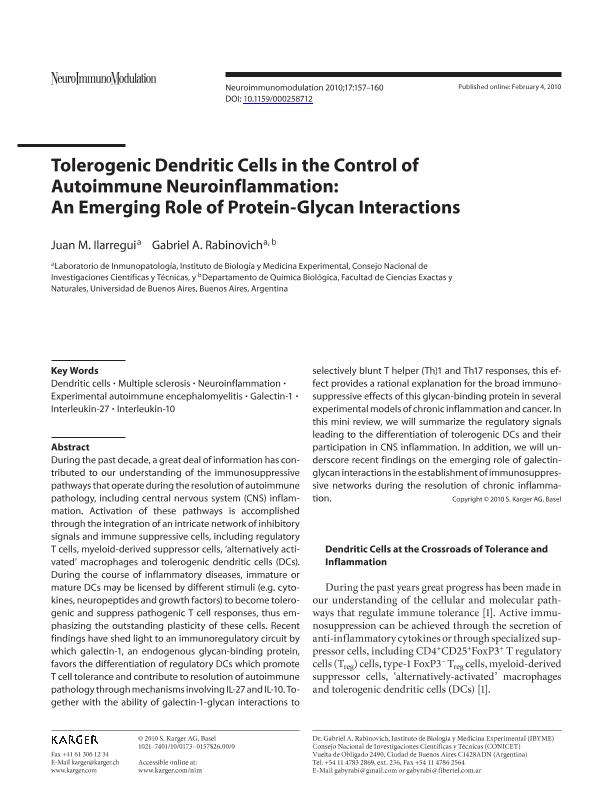Mostrar el registro sencillo del ítem
dc.contributor.author
Ilarregui, Juan Martin

dc.contributor.author
Rabinovich, Gabriel Adrián

dc.date.available
2017-04-03T15:38:14Z
dc.date.issued
2010-12
dc.identifier.citation
Ilarregui, Juan Martin; Rabinovich, Gabriel Adrián; Tolerogenic dendritic cells in the control of autoimmune neuroinflammation: an emerging role of protein-glycan interactions; Karger; Neuroimmunomodulation.; 17; 3; 12-2010; 157-160
dc.identifier.issn
1021-7401
dc.identifier.uri
http://hdl.handle.net/11336/14678
dc.description.abstract
During the past decade, a great deal of information has contributed to our understanding of the immunosuppressive pathways that operate during the resolution of autoimmune pathology, including central nervous system (CNS) inflammation. Activation of these pathways is accomplished through the integration of an intricate network of inhibitory signals and immune suppressive cells, including regulatory T cells, myeloid-derived suppressor cells, 'alternatively activated' macrophages and tolerogenic dendritic cells (DCs). During the course of inflammatory diseases, immature or mature DCs may be licensed by different stimuli (e.g. cytokines, neuropeptides and growth factors) to become tolerogenic and suppress pathogenic T cell responses, thus emphasizing the outstanding plasticity of these cells. Recent findings have shed light to an immunoregulatory circuit by which galectin-1, an endogenous glycan-binding protein, favors the differentiation of regulatory DCs which promote T cell tolerance and contribute to resolution of autoimmune pathology through mechanisms involving IL-27 and IL-10. Together with the ability of galectin-1-glycan interactions to selectively blunt T helper (Th)1 and Th17 responses, this effect provides a rational explanation for the broad immunosuppressive effects of this glycan-binding protein in several experimental models of chronic inflammation and cancer. In this mini review, we will summarize the regulatory signals leading to the differentiation of tolerogenic DCs and their participation in CNS inflammation. In addition, we will underscore recent findings on the emerging role of galectin-glycan interactions in the establishment of immunosuppressive networks during the resolution of chronic inflammation.
dc.format
application/pdf
dc.language.iso
eng
dc.publisher
Karger

dc.rights
info:eu-repo/semantics/openAccess
dc.rights.uri
https://creativecommons.org/licenses/by-nc-sa/2.5/ar/
dc.subject
Neuroimmunomodulation
dc.subject
Multiple Sclerosis
dc.subject
Galectins
dc.subject
Glicobiology
dc.subject.classification
Patología

dc.subject.classification
Medicina Básica

dc.subject.classification
CIENCIAS MÉDICAS Y DE LA SALUD

dc.subject.classification
Inmunología

dc.subject.classification
Medicina Básica

dc.subject.classification
CIENCIAS MÉDICAS Y DE LA SALUD

dc.title
Tolerogenic dendritic cells in the control of autoimmune neuroinflammation: an emerging role of protein-glycan interactions
dc.type
info:eu-repo/semantics/article
dc.type
info:ar-repo/semantics/artículo
dc.type
info:eu-repo/semantics/publishedVersion
dc.date.updated
2017-03-23T18:22:51Z
dc.identifier.eissn
1423-0216
dc.journal.volume
17
dc.journal.number
3
dc.journal.pagination
157-160
dc.journal.pais
Suiza

dc.journal.ciudad
Basilea
dc.description.fil
Fil: Ilarregui, Juan Martin. Consejo Nacional de Investigaciones Científicas y Técnicas. Instituto de Biología y Medicina Experimental (i); Argentina; Argentina
dc.description.fil
Fil: Rabinovich, Gabriel Adrián. Consejo Nacional de Investigaciones Científicas y Técnicas. Instituto de Biología y Medicina Experimental (i); Argentina; Argentina. Universidad de Buenos Aires. Facultad de Ciencias Exactas y Naturales. Departamento de Química Biológica; Argentina
dc.journal.title
Neuroimmunomodulation.

dc.relation.alternativeid
info:eu-repo/semantics/altIdentifier/url/https://www.karger.com/Article/Abstract/258712
dc.relation.alternativeid
info:eu-repo/semantics/altIdentifier/url/http://dx.doi.org/10.1159/000258712
Archivos asociados
